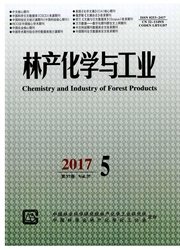

 中文摘要:
中文摘要:
通过对Pachysolen tannophilus 1770进行紫外诱变和单宁浓度梯度驯化培养,以乙醇产量为筛选指标,筛选获得2株稳定的单宁耐受性突变株P05和P18。比较了突变菌株P18与原始菌株P.tannophilus 1770的单宁耐受性,乙醇耐受性和发酵橡子淀粉产乙醇的情况。结果表明,P05和P18有稳定的遗传特性,经5代传代后发酵70 g/L除单宁的橡子淀粉时,P05和P18发酵液中乙醇质量浓度达到71.30和77.07 g/L,较原始出发菌株P.tannophilus 1770增加了13.95%和23.17%。P18有较好的乙醇耐受性和单宁耐受性,相比原始菌株P.tannophilus 1770,在含单宁2.00%的培养基中,P18生物量增加53.33%,在含单宁2.50%的培养基中生物量增加43.48%;在含乙醇2.00%的培养基中生物量增加8.82%。采用突变菌株P18发酵橡子淀粉可以将橡实单宁的浸提取次数从5次减少到3次,从而可以简化生产工艺,降低生产成本。突变菌株P18发酵浸提3次橡子淀粉的最适发酵温度为30℃,最适初始p H值为5.5,最适接种量为6.0%~8.0%,在此发酵条件下发酵液中乙醇质量浓度达到85.18 g/L,乙醇产量达到0.37 g/g。
 英文摘要:
英文摘要:
Two tannin-tolerance mutant strains P05 and P18 were obtained by UV irradiation,tannin gradient domestication and screening with Pachysolen tannophilus 1770 as the starting strain and the ethanol yield rate as screening factor. The tannin and ethanol tolerances of P18 and the original strain P. tannophilus 1770 were studied. The fermentation of acorn starch for ethanol production were also compared. The results showed that the genetic characters of P05 and P18 were stable. After generation through five passages,the ethanol concentrations in the fermentation liquid of P05 and P18 with 70 g / L acorn starch reached71. 30 and 77. 07 g / L,and increased by 13. 95% and 23. 17% than that of P. tannophilus 1770,respectively. Compared with P. tannophilus 1770,P18 had better tannin tolerance and ethanol tolerance,the biomass of P18 increased 53. 33% in the medium of 2. 00% tannin,and increased 43. 48% in the medium of 2. 50% tannin. On the other hand,the ethanol tolerance of P18 increased 8. 82% with the medium of 2. 00% ethanol. By using P18,the extraction process in fermentation could decrease from5 to 3 times. This simplify the production process and reduce the ethanol production cost. The optimal fermentation conditions of the acorn starch extracted for 3 times using P18 were determined as temperature 30 ℃,the p H value 5. 5,and the inoculation quantity 6. 0%- 8. 0%. The ethanol concentration in the fermentation liquid reached 85. 18 g / L under these conditions,and the ethanol yield reached 0. 37 g / g.
 同期刊论文项目
同期刊论文项目
 同项目期刊论文
同项目期刊论文
 期刊信息
期刊信息
